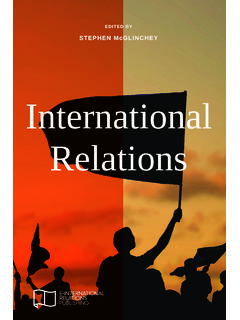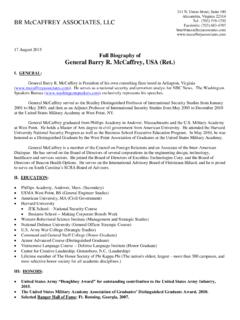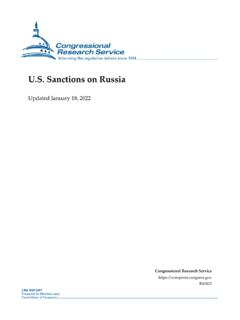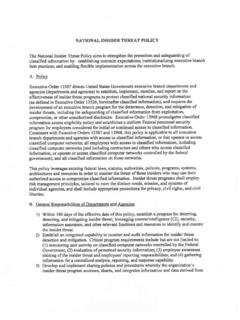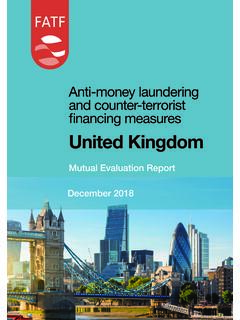Transcription of COUNTERING TERRORISM ONLINE WITH ARTIFICIAL …
1 COUNTERING TERRORISM ONLINE WITH ARTIFICIAL INTELLIGENCEAN OVERVIEW FOR LAW ENFORCEMENT AND counter - TERRORISM AGENCIES IN SOUTH ASIA AND SOUTH-EAST ASIA3 COUNTERING TERRORISM ONLINE WITH ARTIFICIAL INTELLIGENCEAn Overview for Law Enforcement and counter - TERRORISM Agencies in South Asia and South-East AsiaA Joint Report by UNICRI and UNCCT4 Disclaimer The opinions, findings, conclusions and recommendations expressed herein do not necessarily reflect the views of the Unit-ed Nations, the Government of Japan or any other national, regional or global entities involved. Moreover, reference to any specific tool or application in this report should not be considered an endorsement by UNOCT-UNCCT, UNICRI or by the United Nations designation employed and material presented in this publication does not imply the expression of any opinion whatsoev-er on the part of the Secretariat of the United Nations concerning the legal status of any country, territory, city or area of its authorities, or concerning the delimitation of its frontiers or boundaries.
2 Contents of this publication may be quoted or reproduced, provided that the source of information is acknowledged. The au-thors would like to receive a copy of the document in which this publication is used or quoted. Acknowledgements This report is the product of a joint research initiative on counter - TERRORISM in the age of ARTIFICIAL intelligence of the Cyber Security and New Technologies Unit of the United Nations counter - TERRORISM Centre (UNCCT) in the United Nations Office of counter - TERRORISM (UNOCT) and the United Nations Interregional Crime and Justice Research Institute (UNICRI) through its Centre for ARTIFICIAL Intelligence and Robotics. The joint research initiative was funded with generous contributions from United Nations Office of counter - TERRORISM (UNOCT), 2021 United Nations Office of counter - TERRORISM S-2716 United Nations 405 East 42nd Street New York, NY 10017 Website: United Nations Interregional Crime and Justice Research Institute (UNICRI), 2021 Viale Maestri del Lavoro,10, 10127 Torino Italy Website: E-mail: 5 FOREWORD ARTIFICIAL intelligence (AI) can have, and already is having, a profound impact on our society, from healthcare, agri-culture and industry to financial services and education.
3 However, as the United Nations Secretary-General Ant nio Guterres stated in his 2018 Strategy on New Technologies, [w]hile these technologies hold great promise, they are not risk-free, and some inspire anxiety and even fear. They can be used to malicious ends or have unintended negative consequences . AI embodies this duality perhaps more than any other emerging technology today. While it can bring improvements to many sectors, it also has the potential to obstruct the enjoyment of human rights and fundamen-tal freedoms in particular the rights to privacy, freedom of thought and expression, and non-discrimination. Thus, any exploration of the use of AI-enabled technologies must always go hand-in-hand with efforts to prevent potential infringement upon human rights .
4 In this context, we have observed many international and regional organizations, national authorities and civil society organizations working on initiatives aimed at putting in place ethical guidelines regarding the use of AI, as well as the emergence of proto-legal duality is most obviously prevalent ONLINE , where increased terrorist activity is a growing challenge that is be-coming almost synonymous with modern TERRORISM . Consider that as part of 2020 Referral Action Day, Europol and 17 Member States identified and assessed for removal as many as 1,906 URLs linking to terrorist content on 180 platforms and websites in one day. Facebook has indicated that over the course of two years it removed more than 26 million pieces of content from groups such as the Islamic State of Iraq and the Levant (ISIL) and Al-Qaida.
5 The Internet and social media are proving to be powerful tools in the hands of such groups, enabling them to communicate, spread their messages, raise funds, recruit supporters, inspire and coordinate attacks, and target vulnerable the United Nations Global- counter TERRORISM Strategy (A/RES/60/288), Member States resolved to work with the United Nations with due regard to confidentiality, respecting human rights and in compliance with other obligations under international law, to explore ways to coordinate efforts at the international and regional levels to counter ter-rorism in all its forms and manifestations on the Internet and use the Internet as a tool for COUNTERING the spread of TERRORISM .
6 At the same time, the Strategy recognizes that Member States may require assistance to meet these com-mitments. Through the present report a product of the partnership between the United Nations counter - TERRORISM Centre in the United Nations Office of counter - TERRORISM and the United Nations Interregional Crime and Justice Research Institute through its Centre for ARTIFICIAL Intelligence and Robotics we seek to explore how AI can be used to combat the threat of TERRORISM ONLINE . 6 Recognizing the threat of TERRORISM , growing rates of digitalization and burgeoning young, vulnerable and ONLINE pop-ulations in South Asia and South-East Asia, this report provides guidance to law enforcement and counter - TERRORISM agencies in South Asia and South-East Asia on the potential application of AI to counter TERRORISM ONLINE , as well as on the many human rights , technical and political challenges they will need to consider and address should they opt to do so.
7 Our work does not end here. Addressing the challenges identified in this report and unlocking the potential for using AI to counter TERRORISM will require further in-depth analysis. Our Offices stand ready to support Member States and other counter - TERRORISM partners to prevent and combat TERRORISM , in all its forms and manifestations, and to explore innovative and human rights -compliant approaches to do VoronkovUnder-Secretary-General United Nations Office of counter - TERRORISM Executive Director United Nations counter - TERRORISM CentreAntonia Marie De MeoDirector United Nations Interregional Crime and Justice Research Institute7 EXECUTIVE SUMMARYThe integration of digital technologies into everyday life has increased at an extraordinary pace in South Asia and South-East Asia in recent years.
8 With the use of social media by the regions notably young population surpassing the global average. While this trend offers a wide range of opportunities for development, the freedom of expression, polit-ical participation, and civic action, it also increases the risk of potentially vulnerable youths being exposed to terrorist ONLINE content produced by terrorist and violent extremist groups ONLINE . Additionally, given an established terrorist and violent extremist presence in South Asia and South-East Asia, law enforcement and counter - TERRORISM agencies in these regions are increasingly pressed to adapt to transformations in criminal and terrorist activities, as well as to how investigations into these activities are carried out.
9 ARTIFICIAL intelligence (AI) has received considerable attention globally as a tool that can process vast quantities of data and discover patterns and correlations in the data unseen to the human eye, which can enhance effectiveness and ef-ficiency in the analysis of complex information. As a general-purpose technology, such benefits can also be leveraged in the field of counter - TERRORISM . In light of this, there is growing interest amongst law enforcement and counter -ter-rorism agencies globally in exploring how the transformative potential of AI can be unlocked. Considering the aforementioned trends and developments, this report serves as an introduction to the use of AI to counter TERRORISM ONLINE for law enforcement and counter - TERRORISM agencies in the regions of South Asia and South-East Asia.
10 This report is introductory in nature as a result of the limited publicly available information on the degree of technological readiness of law enforcement and counter - TERRORISM agencies in these regions, which is considered likely to be indicative of limited experience with this technology. In this regard, the report provides a broad assessment of different use cases of AI, demonstrating the opportunities of the technology, as well as curbing out the challenges. The report is intended to serve as an initial mapping of AI, contextualizing possible use cases of the technology that could theoretically be deployed in the regions, whilst juxtaposing this with the key challenges that authorities must overcome to ensure the use of AI is responsible and human rights compliant.










